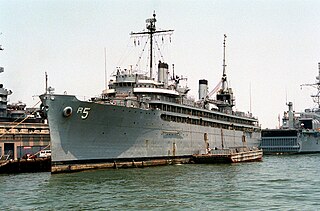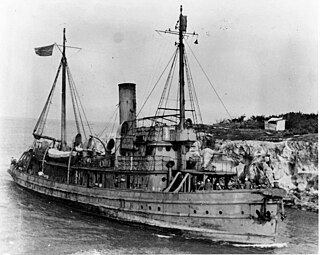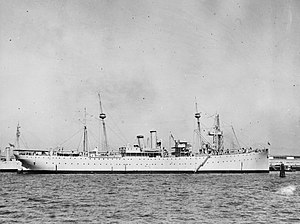
USS Shaw (DD-373) was a Mahan-class destroyer and the second ship of the United States Navy to be named for Captain John Shaw, a naval officer. Commissioned in 1936, Shaw was plagued by construction deficiencies and was not fully operational until 1938. After training in the Atlantic, she was transferred to the Pacific and was berthed in a dry dock in Pearl Harbor on 7 December 1941.

USS Blue Ridge (AGC-2) was an Appalachian-class amphibious force flagship in the United States Navy. She was named for the southeasternmost ridge of the Appalachian Mountains in Virginia and North Carolina.

The Mahan-class destroyers of the United States Navy were a series of 18 destroyers of which the first 16 were laid down in 1934. The last two of the 18, Dunlap and Fanning, are sometimes considered a separate ship class. All 18 were commissioned in 1936 and 1937. Mahan was the lead ship, named for Rear Admiral Alfred Thayer Mahan, an influential historian and theorist on sea power.

USS LST-455 was a United States Navy LST-1-class tank landing ship used in the Asiatic-Pacific Theater during World War II. She was converted at Sydney, Australia, into an Achelous-class repair ship, shortly after commissioning, and used in the repairing of landing craft. Named after the Greek hero Achilles, she was the only US Naval vessel to bear the name.

USS Helm (DD-388) was a Bagley-class destroyer in the United States Navy during World War II. She was named for Rear Admiral James Meredith Helm. Helm received 11 battle stars for her World War II service in the Pacific.

USS Mugford (DD-389), a Bagley-class destroyer, was the 2nd ship of the United States Navy to be named for James Mugford, who commanded the schooner Franklin in the Continental Navy, serving through 1775.

USS Ralph Talbot (DD-390) was a Bagley-class destroyer in the United States Navy, named for USMC Second Lieutenant Ralph Talbot (1897–1918), who was awarded the Medal of Honor during World War I. Talbot served in the Pacific Theater during World War II, from the attack on Pearl Harbor through the battle of Okinawa, earning 14 battle stars for her service.

USS Hutchins (DD-476), was a Fletcher-class destroyer, of the United States Navy named after Naval aviator Lieutenant Carlton B. Hutchins (1904–1938), who though mortally injured, was able to remain at the controls of his aircraft and allow his surviving crew to parachute to safety and was posthumously awarded the Medal of Honor.
USS Medusa (AR-1) was the United States Navy's first purpose-built repair ship. She served in the U.S. Navy from 1924 to 1946.

USS Humphreys (DD-236/APD-12) was a Clemson-class destroyer in the United States Navy during World War II. She was named for Joshua Humphreys, a pioneer US shipbuilder.

USS Trinity (AO-13) was a Patoka-class replenishment oiler of the United States Navy.

USS Welles (DD-628), a Gleaves-class destroyer, was the second ship of the United States Navy to be named for Gideon Welles.

USS Mahan (DD-364) was the lead ship of the United States Navy's Mahan-class destroyers. The ship was named for Rear Admiral Alfred Thayer Mahan, a 19th-century naval historian and strategic theorist. Her design ushered in major advances over traditional destroyers. Among them were a third set of quadruple torpedo tubes, protective gun shelters, and emergency diesel generators. Along with a steam propulsion system that was simpler and more efficient to operate.

USS Bagley (DD-386), a Bagley-class destroyer, was the third ship of the United States Navy to be named for Ensign Worth Bagley, officer during the Spanish–American War, distinguished as the only U.S. naval officer killed in action during that war.

USS Drayton (DD-366) was a Mahan-class destroyer in the United States Navy before and during World War II. She was the second ship named for Captain Percival Drayton, a career naval officer who served during the American Civil War.

The second USS Perkins (DD–377) was a Mahan-class destroyer in the United States Navy before and during World War II and named in honour of Commodore George Hamilton Perkins an officer in the United States Navy during the American Civil War.

USS Wasatch (AGC-9) was a Mount McKinley-class amphibious force command ship, named after a mountain chain in northern Utah. She was designed as a cargo ship and converted into an amphibious force flagship, a floating command post with advanced communications equipment and extensive combat information spaces to be used by the amphibious forces commander and landing force commander during large-scale operations.

USS Vulcan (AR-5) was the lead ship of her class of repair ships of the United States Navy. The ship was laid down on 16 December 1939 at Camden, New Jersey, by the New York Shipbuilding Corporation; launched on 14 December 1940; sponsored by Mrs. James Forrestal, wife of the Under Secretary of the Navy; and commissioned at the Philadelphia Navy Yard on 14 June 1941, Commander Leon S. Fiske in command.

USS Sonoma (AT-12) was a Sonoma-class fleet tug which had the distinction of serving her country during World War I and World War II. For her work as a tugboat in some very dangerous battle areas, she earned five battle stars during World War II. She ended her battle career when she was sunk by a crashing Japanese bomber.

The Altair class destroyer tender was a class of three United States Navy destroyer tenders. These ships were built in Skinner & Eddy's Seattle shipyard as commercial cargo ships during World War I, and acquired by the Navy when the shipyard closed in 1921. All three served through World War II, and were decommissioned and scrapped shortly after the war.


















